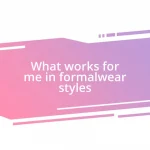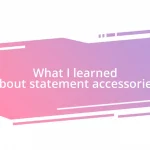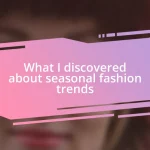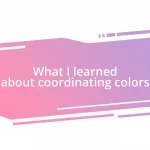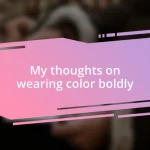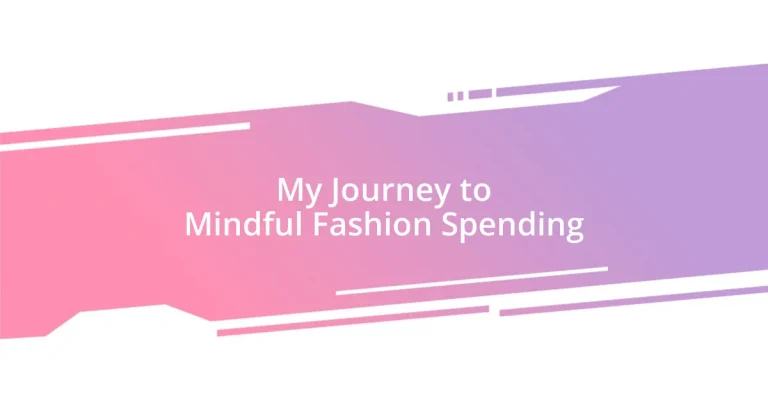Key takeaways:
- Mindful fashion spending encourages awareness of emotional triggers and intentionality behind purchases, promoting healthier shopping habits.
- Creating a fashion budget and implementing the “one-in, one-out” philosophy help manage spending and maintain a curated wardrobe.
- Adopting a capsule wardrobe and reflecting on purchases regularly fosters a deeper connection with clothing, enhancing personal style and satisfaction.
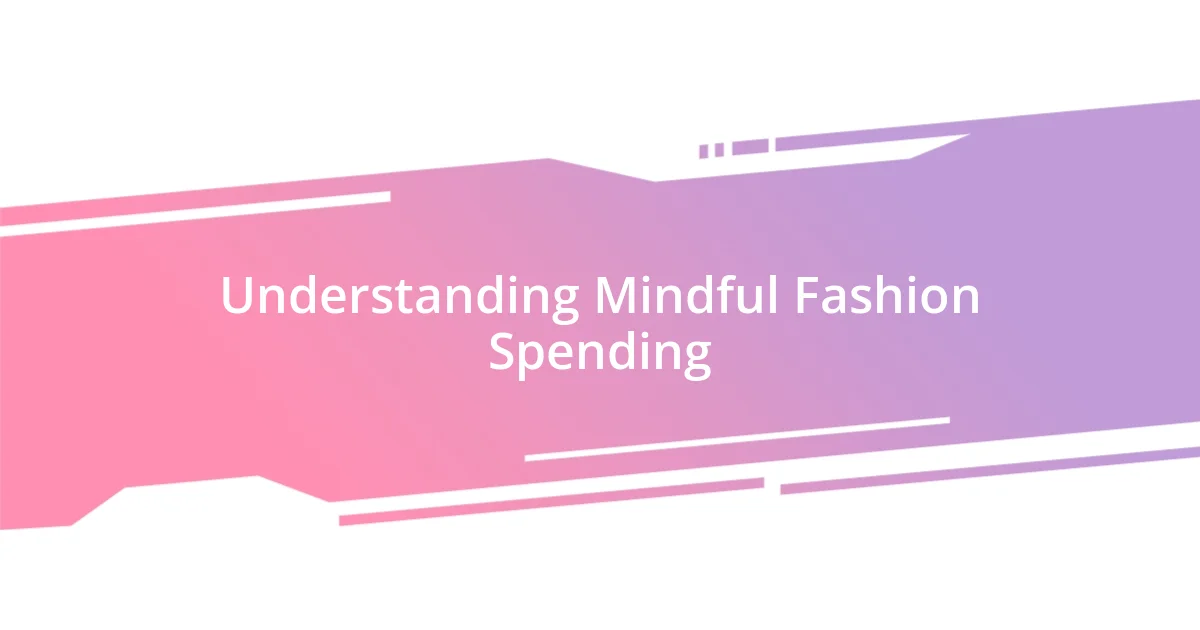
Understanding Mindful Fashion Spending
Mindful fashion spending is more than just a trend; it’s a way to cultivate a deeper connection with our wardrobe. I still remember that moment when I stared at a closet overflowing with clothes—yet I felt like I had nothing to wear. Have you ever felt that way? This realization sparked my journey toward a more intentional approach to my clothing purchases.
When we think about how often we shop, it’s easy to get lost in the allure of fast fashion. For instance, I used to purchase clothes on impulse during sale seasons, only to realize later that many of those items didn’t fit my style or lifestyle. Have you experienced that buyer’s remorse too? By shifting my perspective, I began asking myself: “Will I truly wear this item more than a few times?” This simple question has transformed the way I shop.
Understanding mindful fashion spending also involves recognizing the emotional triggers that lead us to shop. I recall a particularly challenging week when I felt down and decided to cheer myself up with a shopping spree. Though it felt good in the moment, it ultimately didn’t fill the void I was trying to address. It made me realize that being mindful means understanding the “why” behind our purchases, allowing us to develop healthier habits and a wardrobe that truly reflects who we are.
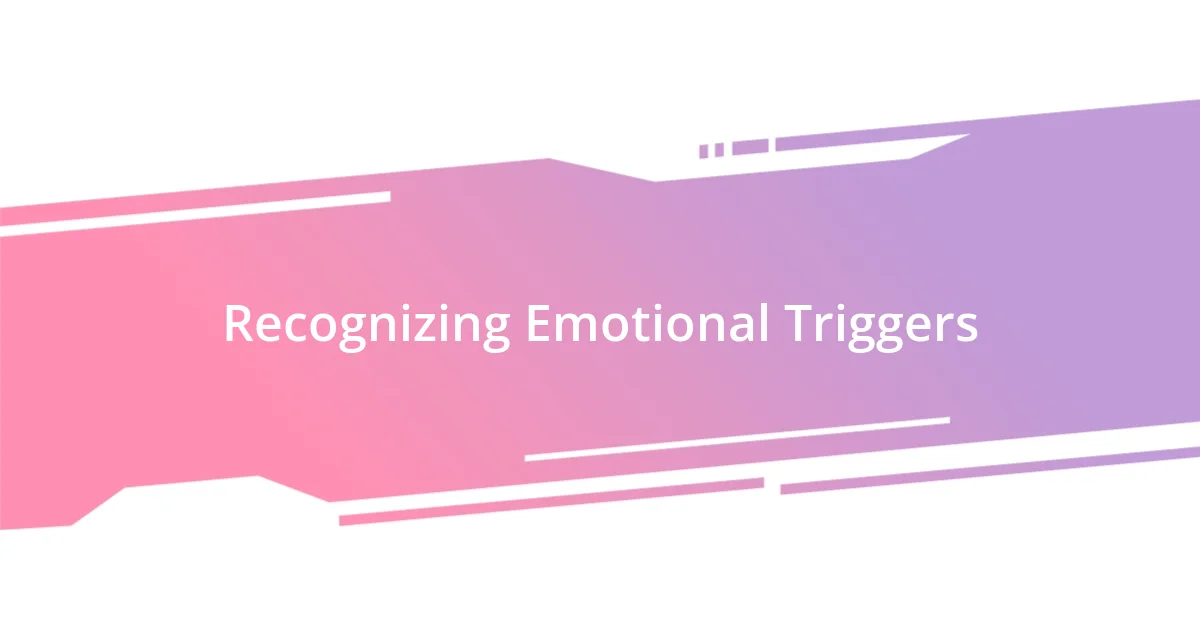
Recognizing Emotional Triggers
Recognizing emotional triggers is a crucial step in my mindful fashion journey. There was a time when I’d scroll through social media, seeing influencers flaunting the latest trends, and feel an intense pull to mimic their wardrobes. It was like a magnetic force, and I’d often purchase items not because I loved them, but because they represented a version of myself I aspired to be. I had to confront the fact that my shopping habits were often tied to feelings of inadequacy or the desire for validation.
Here’s a quick list of emotional triggers I’ve identified in my own shopping behavior:
- Stress or Anxiety: Shopping became a way to escape overwhelming feelings.
- Boredom: I’d buy clothes simply to fill my time, not because I needed anything new.
- Social Influence: Being swayed by friends or trends, rather than my true needs.
- Celebration or Rewards: Treating myself after a tough week, without considering if I truly wanted the items.
- Low Self-Esteem: Equating new clothes with a potential boost in confidence, which often fell flat.
Becoming aware of these triggers has been an eye-opener for me. I now pause before making a purchase, asking myself if it aligns with my values and emotional state. This practice has been liberating, allowing me to shop more thoughtfully.
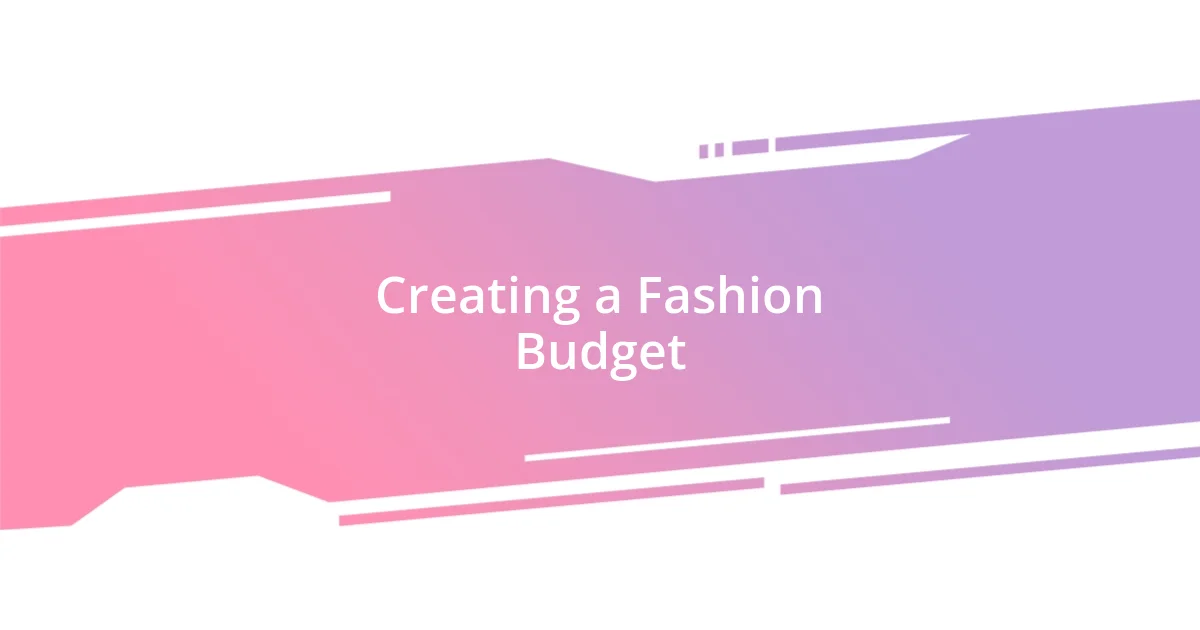
Creating a Fashion Budget
Creating a fashion budget is a foundational step in mindful spending that can completely transform your relationship with clothing. I remember when I first calculated how much I was spending on clothes each month. The number shocked me! By creating a budget, I could set limits, ensuring that every dollar spent was aligned with my values and intentions regarding fashion.
When developing a budget, it’s helpful to categorize your expenses. For example, I like to allocate specific amounts for essentials, trends, and even occasional splurges. The key here is to be honest about what you truly need versus what’s simply enticing. It felt incredibly liberating to know that I had money set aside for that perfect jacket when I needed it, instead of splurging on multiple impulsive buys.
Another approach that worked for me was embracing the “one-in, one-out” philosophy. For every new piece I added to my wardrobe, I made a commitment to donate or sell another. This not only keeps my closet from overflowing but also encourages me to think carefully about new purchases. Have you ever considered how much a streamlined wardrobe can bring clarity to your fashion spending decisions?
| Category | Monthly Budget |
|---|---|
| Essentials | $100 |
| Trendy Pieces | $50 |
| Occasional Splurge | $75 |
| Donation/Sale Funds | $25 |
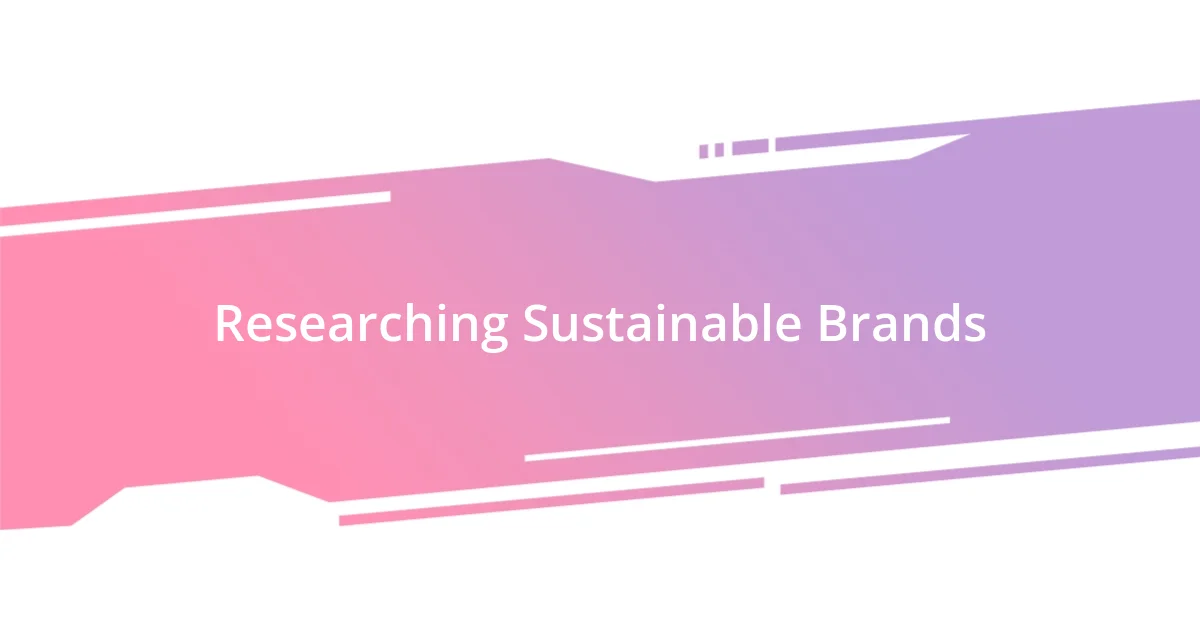
Researching Sustainable Brands
Researching sustainable brands can feel overwhelming at first, but I found it to be a rewarding exploration. My journey began when I stumbled upon a documentary showcasing fashion’s environmental impact. I remember feeling a mix of concern and curiosity as I realized how my shopping habits contributed to this issue. By diving into brand stories, I discovered companies prioritizing ethical practices and eco-friendly materials, transforming my perspective on fashion.
One platform that really helped me was Good On You, which rates fashion brands based on their sustainability efforts. I would spend evenings scrolling through their assessments, feeling inspired by brands dedicated to transparency and fair labor. It struck me that I wasn’t just supporting a brand; I was supporting a movement towards responsible fashion. Have you ever felt the thrill of finding a brand that genuinely aligns with your values? The moment I did, I could almost hear my closet sigh in relief.
I also made it a habit to check a brand’s sustainability claims through third-party certifications. This approach has kept me grounded and helped me avoid greenwashing—a term that refers to misleading claims of being environmentally friendly. One time, I had my eye on a gorgeous dress but paused when I couldn’t verify its ethical standards. Trust me, it was worth the wait to find something that felt good in my heart as well as on my body.
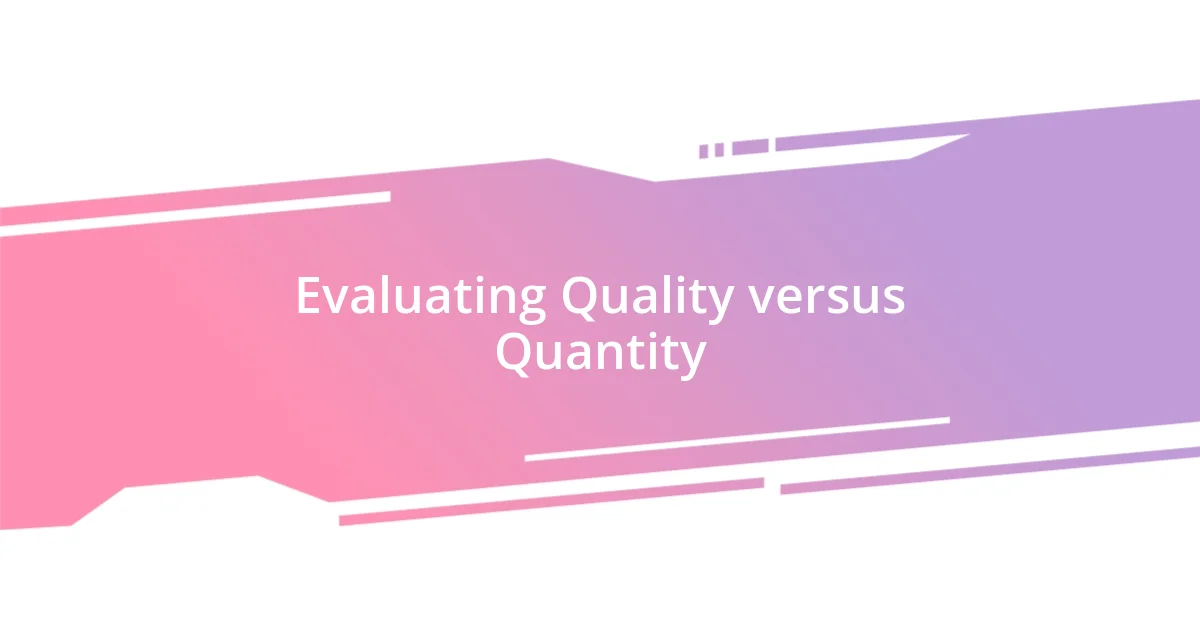
Evaluating Quality versus Quantity
When evaluating quality versus quantity in fashion, the difference can often feel like night and day. I remember my early days of buying clothes on clearance, thinking I was saving money. However, I’d soon find myself with numerous items that barely lasted a season, prompting more waste and regret. It dawned on me that investing in a few well-made pieces—like a classic trench coat or a sturdy pair of boots—was far more rewarding than a closet stuffed with items I’d regret purchasing.
Quality isn’t just about how a piece looks; it’s about how it feels over time. I’ve had that beloved cashmere sweater for years, and every time I wear it, I feel a spark of joy. In contrast, the fast-fashion dresses I used to buy? They often left me feeling uninspired, and I rarely wore them after the initial excitement wore off. Isn’t it fascinating how a single piece of high-quality clothing can elevate your entire wardrobe and mood?
Ultimately, it’s about understanding your personal style and needs. Ask yourself: what pieces truly resonate with me? In my experience, when I choose quality over quantity, my closet evolves into a curated collection. Each item becomes a favorite, a true reflection of who I am. Wouldn’t it be great if we could all experience that kind of empowerment in our fashion choices?
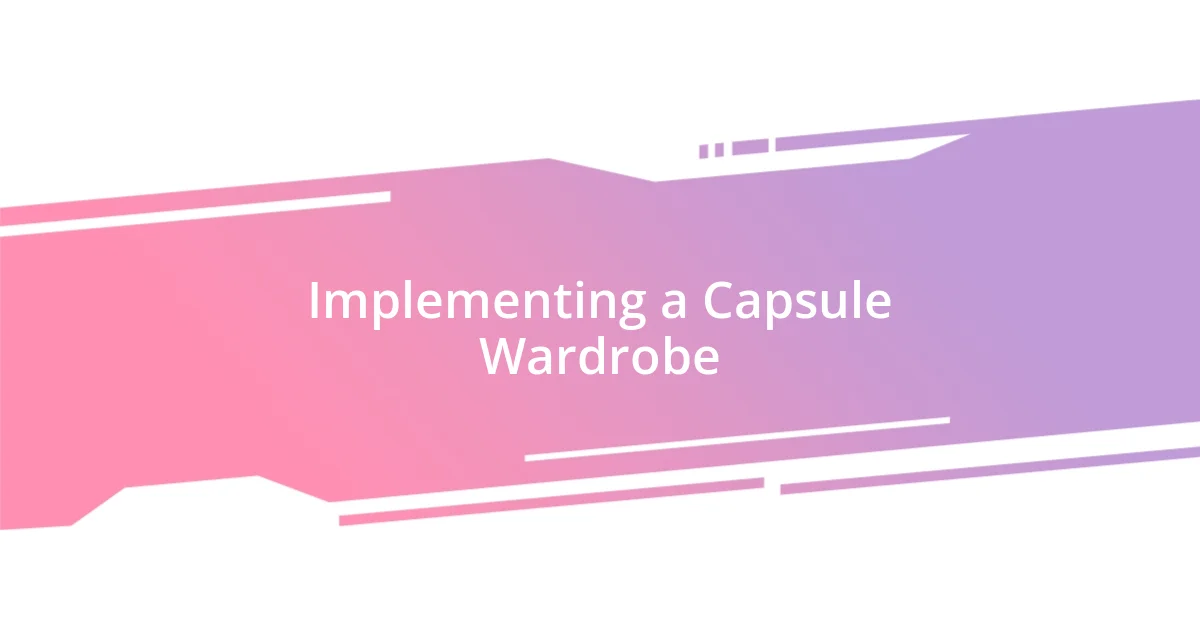
Implementing a Capsule Wardrobe
Implementing a capsule wardrobe requires a thoughtful curation of pieces that truly reflect your style. As I began this journey, I remember the sense of liberation I felt when I finally let go of clothes that no longer served me. It was like shedding an old skin and making room for a fresh and intentional collection. Have you ever experienced that exhilarating moment when you realize less can actually mean more?
For my capsule wardrobe, I focused on versatile staples that could be mixed and matched. One day, I paired a simple white blouse with dark jeans, and the next—a chic skirt. This intentional selection made getting dressed in the morning a breeze, eliminating decision fatigue. I can’t express how empowering it is to step out and feel confident, knowing I love every piece I wear.
The best part? My new capsule wardrobe not only streamlined my daily routine but also helped me cultivate a more mindful approach to shopping. I now enter stores with a clear vision, asking myself if an item adds value to my curated collection. Reflecting on that change, it’s incredible how a closet with fewer items has sparked creativity and joy in my fashion choices.
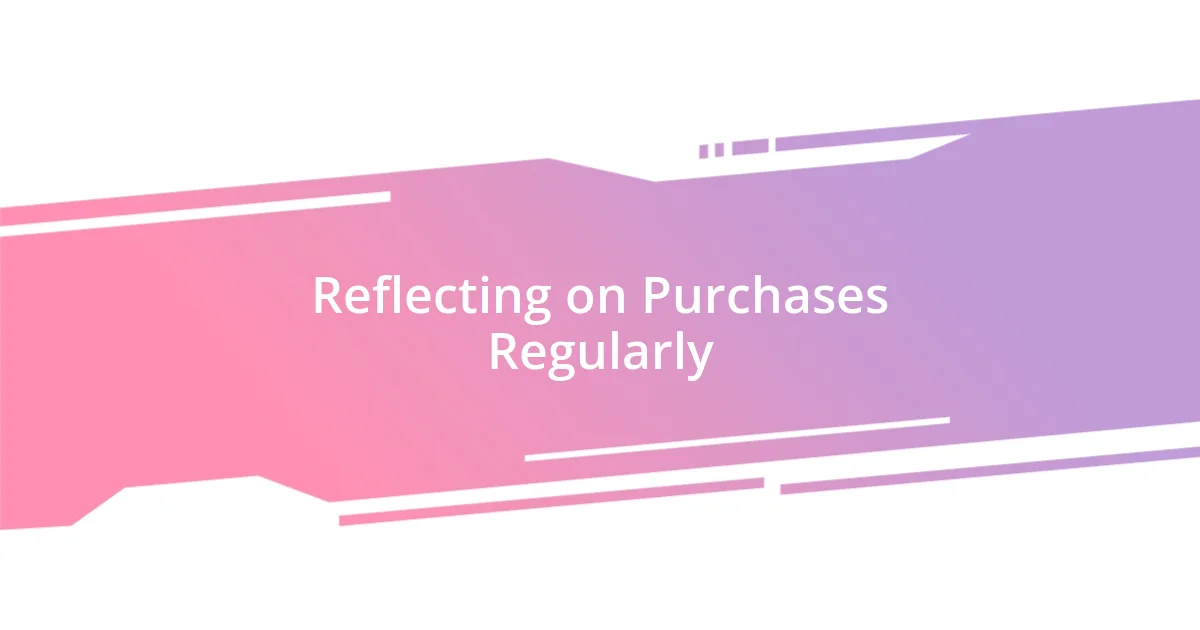
Reflecting on Purchases Regularly
Reflecting on my purchases has been a game changer in my mindful fashion journey. I’ve started keeping a simple journal where I jot down not just what I bought, but how I felt about it afterward. When I revisit these notes, it’s eye-opening to see patterns emerge. Have you ever realized that a significant portion of your buys were impulse decisions fueled by a fleeting crave? I definitely did.
After a shopping trip, I take a moment to consider how each piece fits into my life. For example, I once bought a vibrant red dress that caught my eye, but when I reflected on it, I realized it was perfect for a singular event—a night out that didn’t happen often. Now, I ask myself, “Will this really enhance my everyday life or just collect dust?” This has allowed me to channel my funds into those treasured items that can stand the test of time.
It’s fascinating how this practice has demystified my shopping habits. There was a time when I felt overwhelmed by choices, but reflecting regularly on my purchases has given me clarity. I’ve found that the more I engage in this process, the more I appreciate each piece in my wardrobe. Isn’t it surprising how a simple reflection can transform your relationship with fashion and spending?


